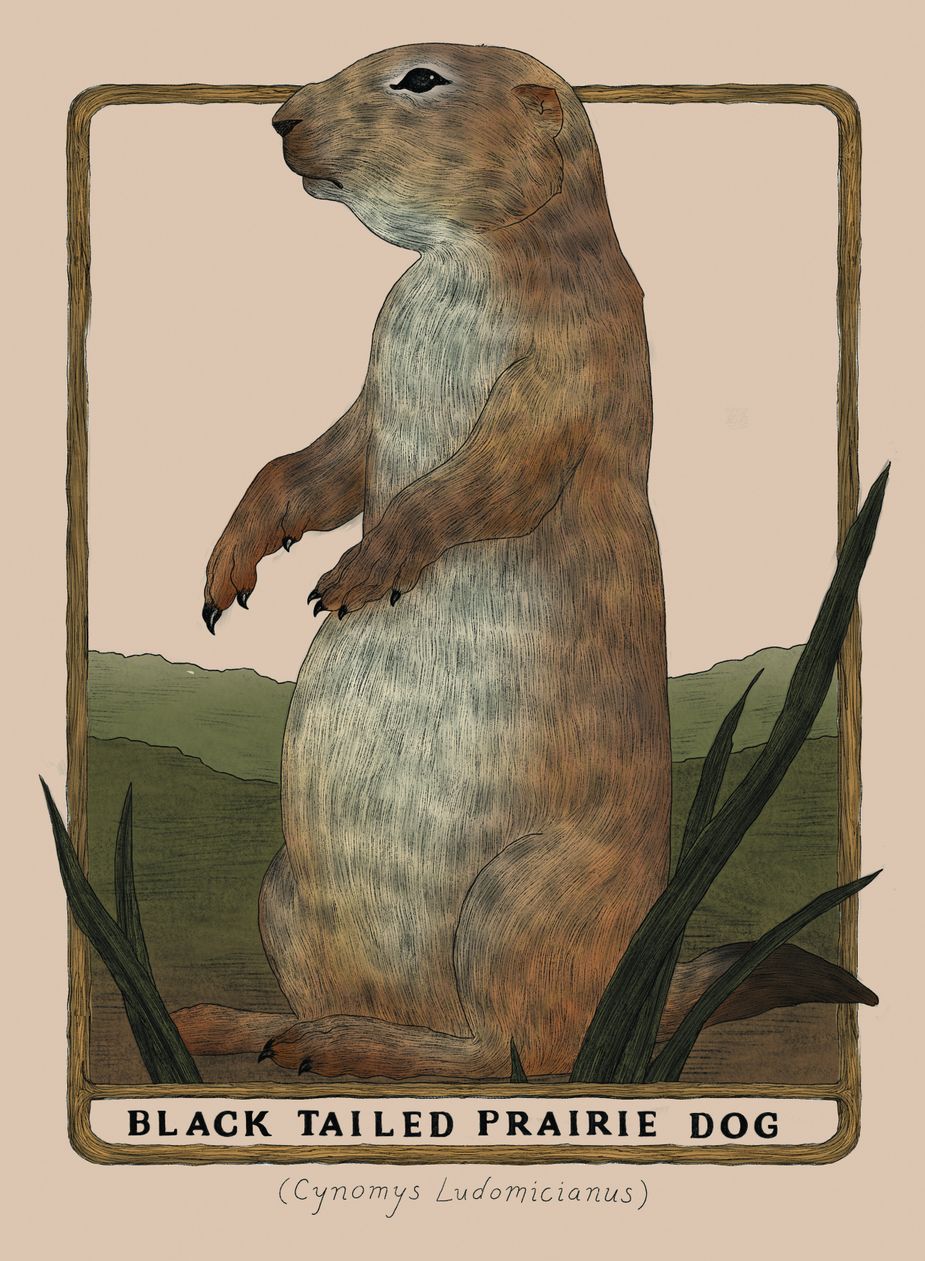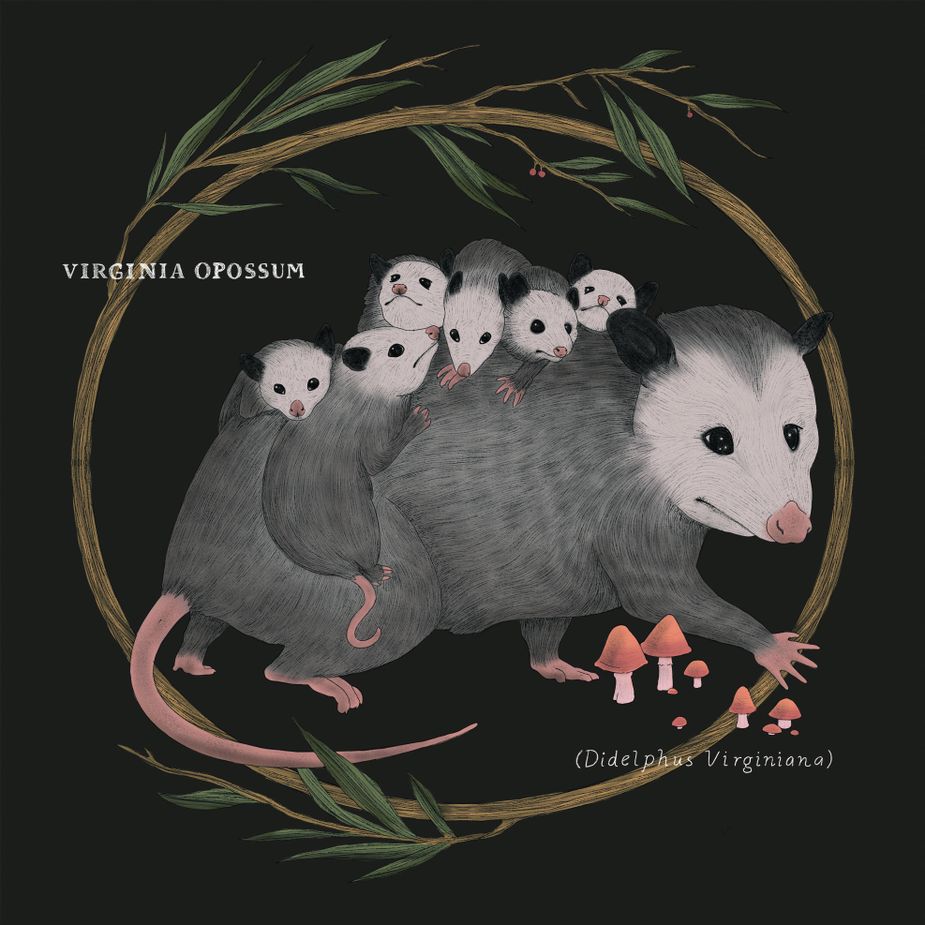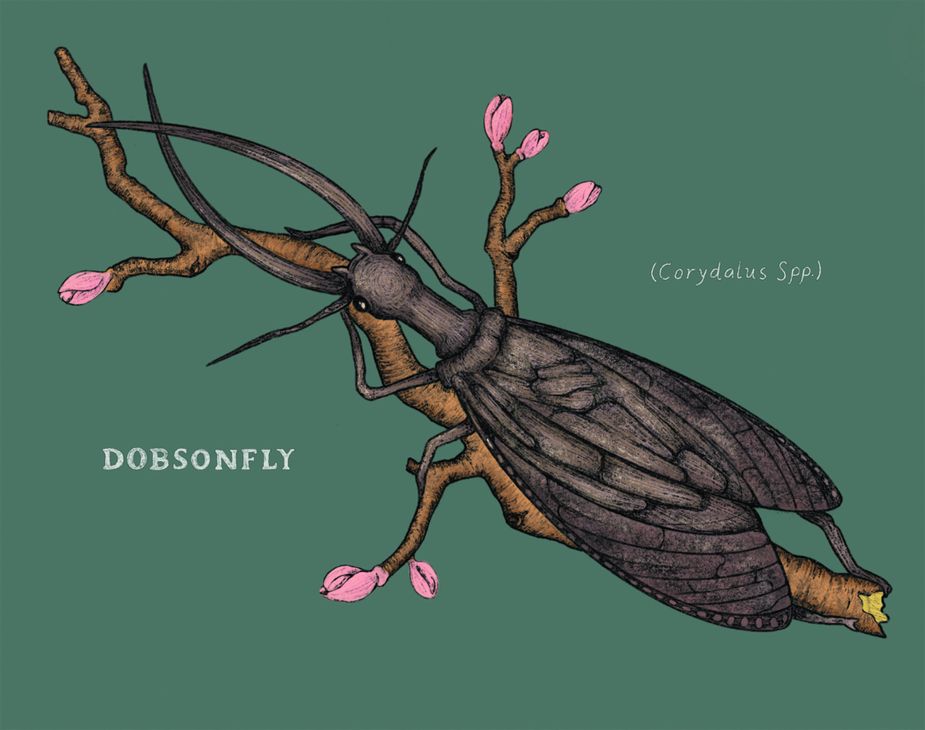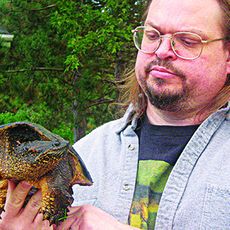Creature Feature
Published February 2022
By Gordon Grice | 21 min read

Black-Tailed Prairie Dog illustration by Danielle Maniguet
Black-Tailed Prairie Dogs
Prairie dogs may have created Oklahoma’s first civilization, building towns that covered dozens of acres long before humans arrived. Each town consists of holes in the ground surrounded by heaps of dug-out dirt with sentries standing watch while others forage. At the first sign of danger—the shadow of a hawk, the sight of a coyote—the sentry sounds an alarm in the form of short, sharp barks. Every citizen runs for a hole. Those holes lead to tunnels that contain not only the prairie dog community but occasionally some uneasy denmates like owls and rattlesnakes.
Prairie dog towns are smaller these days. People have hunted the little mammals for sport or exterminated them as pests. It’s long been believed that their holes are a hazard to livestock—despite the fact that scientists have had trouble finding hard evidence of that supposed danger. Around the turn of the twentieth century, bubonic plague invaded North America, sickening the residents of human cities—as well as the denizens of prairie dog towns. The disease lingers in prairie dog populations today, occasionally wiping out an entire town. Its presence is one reason not to handle prairie dogs. Also, they bite.
Troubles like these have dropped the country’s prairie dog population to five percent of its estimated historic total. Nonetheless, the International Union for Conservation of Nature lists the rodents as a species of least concern.
But it’s not just towns that make a civilization. Scientists have found that prairie dogs have a complex language. Those warning barks? They aren’t just invitations to panic; they contain entire packets of information. For example, the dogs don’t just warn each other about a human approaching but, for example, a tall human in an orange shirt moving very quickly.
Maybe the strangest aspect of prairie dog language is that they appear to use it in mourning. Observers have seen prairie dogs making a distinctive call at companions killed on the road. One observer described an adult trying to retrieve the body of her offspring from the asphalt. And in another incident, seven or eight adults gathered noisily around the body of a companion, seemingly risking their own lives to speak a few words over the dead.
So it’s worth getting to know these complex, misunderstood little creatures.
Visit the Prairie Dog Town four miles west of the Wichita Mountains Visitors Center on State Highway 49.

Evergreen Bagworm Moth illustration by Danielle Maniguet
Evergreen Bagworm
It’s hard to recognize the bagworm as an animal. It looks like part of the tree it lives on, usually a cedar or cypress.
Its home hangs from a bit of greenery the size of a little finger, pointed at both ends, and covered with cedar needles. The flaw in this camouflage appears as the summer wears on: The cedar stays green, but the needles on the bag turn russet. Of course, you might notice the bag moving sometimes too, raising or lowering itself on a silk line. The line, like a single strand of spider web, is too thin to see easily; the green teardrop seems to move by magic.
It’s hard to pluck a bagworm from its mooring. It clings tight and finally parts with a snap. The bag flexes with an inner wormy softness—and it’s tough. If you’re determined enough, it will rip like cloth. That’s when you’ll finally see the worm, black or brown, thrashing in panic. The inner surface of the bag is dark as tobacco spit; layers of silk surround it. The silk makes you realize the “worm” is actually a caterpillar—one that is ill equipped for life outside the bag. Placed on the ground, it can scarcely find its way to cover.
I always felt free to tear open the bags when I was a kid, since the worms are somewhat harmful to the trees. One autumn day, I yanked a bag loose and plucked idly at it the way I might pluck the petals from a daisy. I was shocked when the bag ripped and, instead of the familiar caterpillar, a singularly ugly insect emerged, humped and hairy as a bison. Its feathery antennae wiggled.
This is the moth a bagworm becomes.
Actually, only males become recognizable as moths. The female never leaves her bag nor transforms to winged adulthood. She pokes her head out the top of her cocoon to eat; if necessary, she can heave her entire forward section out to carry her home elsewhere, like a snail carrying its shell. She remains a larva until her death and draws the ungainly male to her by scent. After they mate, she doesn’t bother to make an egg case. She simply dies with the eggs inside her body. Body and bag serve as protection until the tiny larvae emerge. The male is only slightly more active, flopping about in his adult, winged form looking for love for two to seven days before he dies.
The hatchlings crawl away or use strands of silk to sail away on the wind. Each settles down to make its own bag. Another camouflaged life begins
Bagworms can be found on bald cypress, red cedar, oak, and other trees starting in early June. Pluck the bag from the tree and burn it to ensure no eggs survive. Some bacterial insecticides can be used to kill bagworms and larva if applied in June and July.

Eastern Cottontail illustration by Danielle Maniguett
Horned Rabbit
Maybe you’ve seen a stuffed jackalope hanging on the wall of a restaurant or bar. If you’re skeptical, you’ll say it’s a jackrabbit with antlers glued on.
Maybe you’ve heard the lore that goes with it: Cowboys singing around the campfire are startled to notice an extra voice joining in, and it’s coming from a jackalope. They prove this by luring it in with a little Southern Comfort in a saucer.
There’s a wrinkle in this silly story, though: Horned rabbits are real. Sort of.
A woman from Hooker found that out in 2003. She was startled to see among her grandson’s harvest of cottontail rabbits one that had seven horns. They were spars—like the horns of a rhinoceros.
Horned rabbits were rare enough to merit a mention in the Oklahoman, but it already was a well-known phenomenon. Natural histories from as far back as the seventeenth century contain illustrations of horned rabbits, but it seemed like the old authors were being too credulous of reports they heard from the field. In the early 1930s, Richard Shope got involved.
Shope was already important in the field of virology. He recently had discovered a virus in domestic pigs. Within a few years, scientists would prove that this virus was the bug responsible for the 1918 pandemic that killed fifty million people. In the midst of this important research, Shope heard reports of horned rabbits killed by hunters. He had some specimens sent to his lab.
The cottontails sported the odd growths on their bellies, thighs, shoulders, and necks. He cut off some of the horns, ground them up, dissolved them in liquid, and filtered them for viruses. The result was a pathogen that, when applied to healthy rabbits, made them grow horns.
This growth isn’t technically a horn. It’s a tumor. Shope had demonstrated for the first time what now is an accepted medical fact: Viruses can cause cancer. The bug belongs to a family called papillomavirus. A similar virus is responsible for genital warts and cervical cancers in humans.
The Shope papillomavirus, as the rabbit-disfiguring disease now is called, can show up on several species, including Oklahoma’s blacktailed jackrabbit, but its main host is the Eastern cottontail found throughout Oklahoma. The horns can harm a rabbit if they interfere with its ability to eat, but, as Shope observed early on, most infected cottontails go on to live normal lives.
The Oklahoma Department of Wildlife Conservation says those who encounter a rabbit with the Shope pappilomavirus can share the sighting at wildlifedepartment.com. Once there, select "Wildlife Division."

Virginia Opossum illustration by Danielle Maniguet
The Virginia Opossum
Fossil records tell us the opossums of South America once came close to extinction. The reason wasn’t climate change or an asteroid strike. It was an influx of pit vipers. The opossums that survived their dealings with venomous snakes were the ones who had some level of immunity to the venom.
They passed it on. And their descendants include the opossums of Oklahoma.
Events like that create a scenario biologists call “trench warfare co-evolution.” It means that two natural enemies influence each other’s development, each evolving traits for combatting the other.
The opossums of Oklahoma sometimes encounter pit vipers like rattlesnakes, water moccasins, and copperheads. Neither party is especially likely to make the meeting into a meal, but it does happen, and the opossum often comes out with a full belly. One researcher put an opossum into a cage with a mother rattlesnake and her eighteen hatchlings. It ate all eighteen little snakes the first night—but saved the mother for the second night.
In a quirk of biochemistry, the opossum’s immunity extends far beyond its historic enemies. Nowhere in its range will a Virginia opossum meet an Asiatic cobra—but if it did, it would be immune. The same goes for Russell’s viper, a threat to human lives in India, and for the dangerous mamushi of Japan and Korea. The immunity factor isn’t specific to any certain toxin like antibodies are. Instead, it’s a string of amino acids that counteracts many different types of venom. That means, in theory, it could be developed into a general-purpose antivenom people could carry around like an EpiPen.
This could make a huge difference around the world. Venomous snakes kill approximately 125,000 people a year worldwide. In lab tests, scientists at San Jose State University have already found an artificial version of this immunity factor defeats the venoms of the Indian saw-scaled viper, arguably the world’s most lethal snake, and the dangerous African puff adder. Closer to home, the medicine could help not only humans but also pets, who suffer about 150,000 venomous snake bites in the United States every year.
Besides venoms, the opossum can also survive poisons like cyanide, arsenic, and even ricin. Unrelated to this super-immunity, the opossum also has a low body temperature that makes it highly resistant to rabies.
None of that helps the opossum when a predator uses teeth and claws. It can fall victim to coyotes, bobcats, foxes, dogs, raccoons, and owls. Yet even against this sort of predator, its defenses are many. It can waddle away, climb trees or stairs, hiss like a demented vampire, or take to the water. If none of that works, it may fall into a sort of coma. People call that “playing possum,” which makes it sound like a clever strategy. But scientists say it’s involuntary—a fit of fainting, basically. It may last for six hours.
Despite their habit of dying on roads, opossums have done amazingly well with people as neighbors. That’s largely because they like city living. Coyotes and other predators rarely bother them near human habitations, but food items like ticks, mice, roadkill, garbage, and pet food are abundant. And their numbers are increasing. For that reason, your best chance of spotting an opossum is a random encounter around town. They may turn up on your patio, in a gutter at the far reach of your headlights, or even in a tree outside your window. They never look pleased to see you, but everything will be fine if you keep your distance and enjoy the photo opportunity.
The range of these animals also has expanded, and humans are to blame. Their northern limit used to stop somewhere in Kansas, while their western limit was the Rockies. Now, they range well into Canada, possibly because climate change has made the north warmer. And they have a second range in California. That California population took root in the 1930s, apparently a byproduct of human migration from Dust Bowl Oklahoma. Wherever Okies go, we take our land with us.
Medicine Park Aquarium & Natural Sciences Center has a baby opossum. Contact the aquarium in advance to schedule a one-on-one encounter.

Dobsonfly illustration by Danielle Maniguet
Dobsonfly
The world around us is full of life we never see. Extension agents and specialized websites often get panicky emails about some hideous little monster that terrified a hapless citizen, wanting to know what, exactly, it could be.
Take the dobsonfly, for instance. In a typical scenario, a homeowner glances at his porch light and, among the usual moths and lacewings, spots a critter big as a jackknife and armed with massive mandibles. Worse, its knobby eyes seem to be looking at him. It flexes its wings—they might span five inches—as if it’s about to attack. It isn’t, of course—not unless said homeowner goes and pokes it.
If the hapless citizen happens to be a fisherman, there’s a chance he’s met a member of this family before—as bait. Like the butterfly who began as a dumpy caterpillar, the monstrous dobsonfly begins as a long, slender larva. Unlike a caterpillar, it’s covered in armor and already bears mandibles made for killing.
This larval version lives near fast-flowing rivers. Swim by fast enough and you’re safe. (You’re actually safe anyway; come on, it’s only a few inches long.) But let’s say you’re an insect. And let’s say you happen to crawl under the rock where it lies wedged like a finger into a glove. You’ll find yourself chopped by those massive shears.
Depending on the particular species of dobsonfly, some of these predatory larvae are called hellgrammites, and they’re known as a good bait for fish like the smallmouth bass. What makes them suitable for that role is their swimming skills. They can breathe underwater and will move in a way that attracts bass, but they’re not especially fast.
If you’d like to see hellgrammites, your best bet is to go turning over rocks along the river. You’ll likely see all sort of interesting wildlife this way, and so long as you keep an eye out for venomous snakes, you’ll enjoy it. Once you do find a hellgrammite, keep your hands to yourself. It’s not venomous, but it can bite hard enough to draw blood. If you want to catch it for bait, grab it behind the head, and be careful not to let the tail whip around—some species can pinch with that end, too.
The larvae, left to their own devices, may live under stones for two to four years. Then they crawl away from the water and form a hard case around themselves. They stay in this pupa form for a week or two then emerge as little winged dragons. Besides a random encounter at the porch light, people most often see them flitting over rivers. The adult males look formidable, with mandibles sometimes a quarter inch long. These make lousy weapons—their main use is for holding onto females while mating. The smaller shears of the females, however, mean business to any grabby hand.







